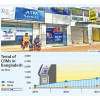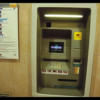Why are CRMs replacing ATMs in Bangladesh? Differences, explained

The familiar hum of an ATM, once a symbol of modern banking convenience, might soon be replaced by a quieter whirring: the sound of Cash Recycler Machines (CRMs) quietly affecting the way Bangladeshis access their cash. While both machines offer self-service banking options, CRMs are rapidly outpacing their one-way counterparts, driven by a wave of efficiency, security, and accessibility benefits. But what are the key differences between ATMs and CRMs and what factors make CRMs a preferred choice for many banks? Let's find out.
Automated Teller Machines (ATMs)
For decades, ATMs have been integral to modern electronic banking. They symbolise the convenience and efficiency of accessing banking services outside traditional bank branches. Originally designed for cash withdrawals, ATMs have evolved to offer a range of services including deposit acceptance, balance inquiries, and credit card payments. However, their fundamental operation has remained largely unchanged. When a customer deposits cash into an ATM, that money is typically not recycled for future withdrawals. Instead, ATMs rely on a separate process of cash replenishment, where the cash for withdrawals is loaded manually by bank staff or secured cash-in-transit services.
Cash Recycling Machines (CRMs)
CRMs, on the other hand, represent a significant advancement in cash handling technology. These machines not only accept deposits but also use the same deposited cash for withdrawals. This recycling of cash eliminates the need for frequent manual replenishment, as the money deposited by one customer can be withdrawn by another. The technology behind CRMs is more complex than that of traditional ATMs. They require sophisticated hardware and software solutions to manage multiple functions - depositing, dispensing, and recycling cash. This multifunctionality makes CRMs inherently more costly than ATMs but offers greater operational efficiency.
Beyond dispensing
The key difference lies in their core functionality. While ATMs primarily dispense cash, acting as automated cashiers, CRMs break the mould by accepting deposits as well. This two-way street translates to significant advantages for both customers and banks.
For customers, the convenience factor soars. Imagine skipping long queues at the bank branch, simply walking up to a CRM, and depositing your earnings or business takings, all while instantly crediting your account. Conversely, withdrawing cash becomes hassle-free, eliminating the need to visit separate machines or branches.
Banks, too, reap the rewards. Fewer queues translate to happier customers, while the efficiency boost allows them to manage more transactions with fewer machines. The cherry on top? Deposited cash stays within the CRM, eliminating the need for frequent, costly cash replenishment and associated security risks.
Security and accuracy
CRMs offer enhanced security and accuracy. Their advanced counting mechanisms go beyond verifying the number of bills deposited, employing sophisticated technology to detect counterfeit notes, safeguarding both customers and banks from fraudulent activity. This meticulous counting also ensures deposits are credited accurately, eliminating human error and streamlining transactions.
Operational and economic benefits
The operational benefits of CRMs are also significant factors in choosing CRMs over ATMs. They reduce labour costs and improve security by minimising the need for manual cash handling. Additionally, they lower the operational expenses associated with loading ATMs with cash for withdrawals. From an economic standpoint, the cost-saving potential of CRMs is a driving factor in their increasing adoption. Banks are recognising the long-term benefits of investing in these machines despite their higher initial cost compared to ATMs.
Trend in Bangladesh and beyond
In Bangladesh, banks are increasingly shifting towards CRMs, a trend that is mirrored globally. This shift is partly driven by the broader adoption of digital banking solutions, such as Mobile Financial Services (MFS), which are reducing the reliance on physical cash. The convenience offered by CRMs, allowing customers to perform multiple transactions at a single point, aligns with the evolving consumer expectations for quick and efficient banking services.
Data from Bangladesh Bank as of 2023 indicated a decline in the number of ATMs, countered by a rise in CRM installations. This trend is reflective of the changing landscape in banking, where operational efficiency and customer convenience are paramount.
The future of banking
While the transition to CRMs is gaining momentum, it's important to recognise that the demand for cash withdrawal services, whether through ATMs or CRMs, will continue for the foreseeable future. This is particularly true in regions where the transition to completely cashless transactions is still in progress. However, the rate of growth for traditional ATMs is expected to decline as CRMs become the preferred choice due to their advanced capabilities and operational benefits.

 For all latest news, follow The Daily Star's Google News channel.
For all latest news, follow The Daily Star's Google News channel. 








Comments